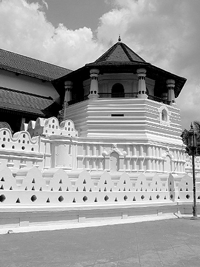Tropical delights of many kinds await those willing to make the long journey
Shantha Pandige watches silently from his brother’s home as his new house goes up next door. To get to this part of Morampitigoda, a village near the southern city of Galle in Sri Lanka, you have to cross a makeshift bridge of narrow wooden planks from the dirt road that gets you only so far. It’s been three months since the tsunami of December 26 hit Sri Lanka, and Pandige and his family are lucky. They’ve survived and at least have a temporary home built near their old one. Fatefully, their house was destroyed while his brother’s somehow remained intact.
Pandige and other surviving villagers will point out, almost with a giddy pride of sorts, just how high the waters came that day. The most striking characteristics of the village, though, are the lack of self-pity and the abundance of welcome. While many thousands nationwide are still living in tents, this community, already poor by Western standards, seems happy to be moving forward.
Before we leave Morampitigoda, someone cuts open the large, smooth-skinned orange coconuts grown here, as a bon voyage beverage. You don’t just toss out the shells, though. “Long Live the Coconut Tree” is a phrase you cannot escape in Sri Lanka—the fruit and the husks will be used for other purposes. In a poor country, nothing is wasted.
Time, on the other hand, is treated quite casually. If you’ve made the two-day journey to Sri Lanka, you undoubtedly want to relax, but Sri Lankans tend to operate more slowly than you probably like. The 2:15 car that is arranged to meet you might arrive at 3 p.m. instead. Your waiter will disappear indefinitely. The harried New Yorker will either appreciate the lowering of the blood pressure, or burst.

Sri Lanka, probably not looming large in the consciousness of too many Americans until the tsunami, has typically been overshadowed by its large neighbor, India. Most articles and books about Sri Lanka label it “a tropical paradise” and that’s no exaggeration. Birds you’ve never heard serenade you awake even amidst the choking pollution of Colombo, the capital city. Outside the cities, things get even more lush, and you can cover a lot of ground in two weeks. The island offers stunning palaces and giant Buddhas, natural wonders galore and wildlife parks. Hiring a driver is not all that expensive, and can easily be arranged by travel agents and hotels. Many of the drivers and other guides have taken courses in Sri Lankan history and culture and can answer any question you might have. They offer a lot of information spontaneously also, saying, “Come, come,” as they show you something new.
Beyond the travel professionals who are friendly for hire, there is a population, of all classes, that seems proud of their country and eager to share an insight or a suggestion. If you’ve every traveled places where the locals are indifferent or even downright taciturn, you will appreciate the smiling countenance of the average Sri Lankan. The people truly are this country’s most compelling resource.
That’s a welcome attitude to find after a journey halfway around the world.
Sri Lanka offers a variety of cuisines, including its own specialties, along with wonderful fresh fruits, like papaya and a pineapple edible all the way to the core. Some of the highlights:

Hop to It: One specialty is the hopper, a crepe of sorts that is served at any meal, usually topped with eggs, honey or whatever’s being served. Caterers have cooks specializing in making hoppers. A distinctive banging noise accompanies the dislodging of the hopper from the pan.
gaycitynews.com



































